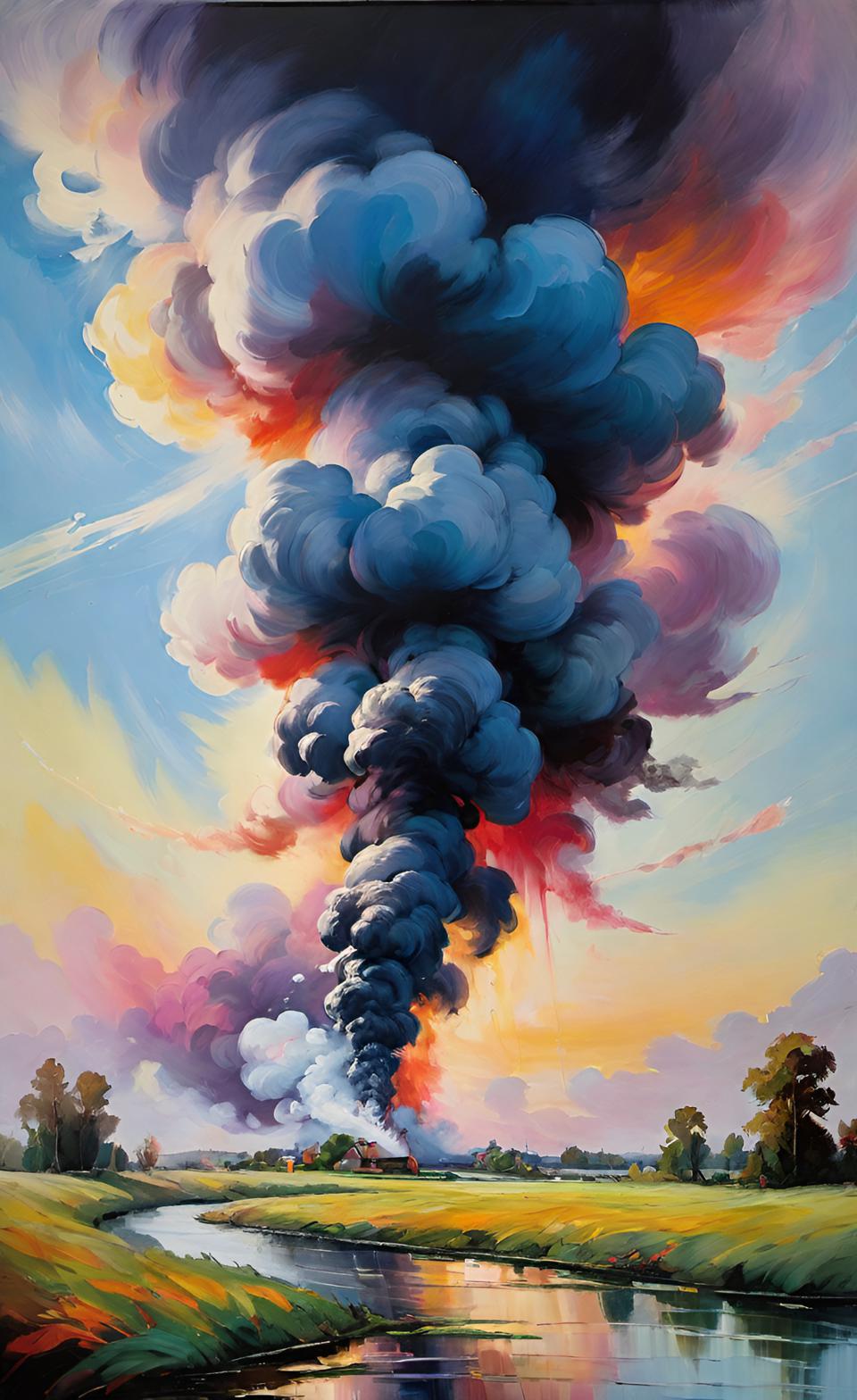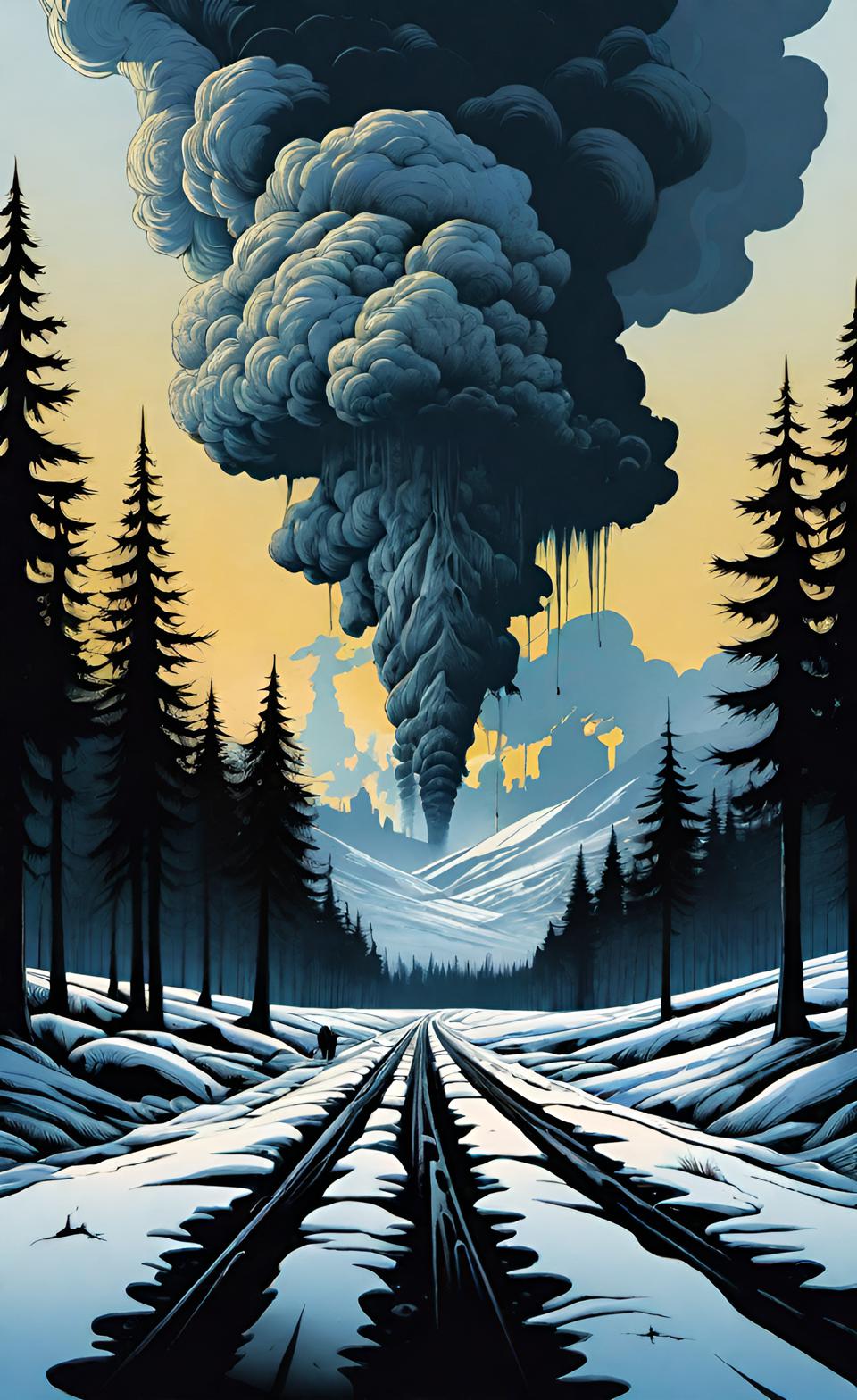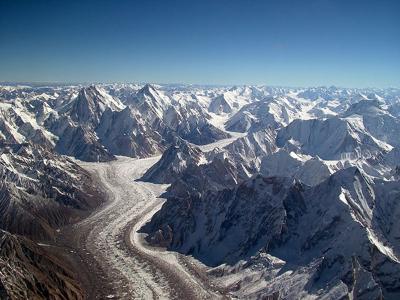- Air Homepage
- Alberta Air Quality
- Air Quality Dispersion Modelling
- Long-range Transport
How long-range transport impacts air pollution and how emissions spread.
There's a phenomenon called long-range transport that makes air pollution not just a local problem. In order to predict where pollutants will land, you may need a domain as large as 50 km by 50 km in situations when emissions rise from tall stacks with buoyant plumes.
 The path of pollution is shaped by terrain
The path of pollution is shaped by terrainThese areas often include spots with sensitive receptors such as hospitals, schools, and residential communities. The size of the area to consider should include where pollutants are predicted exceed 10% of air quality standards. The size and shape of this domain are typically influenced by terrain, weather and nearby emission sources.
Shorter stacks are often adequately modelled using smaller modelling areas, but still pose risks on the nearby population and environment. The CALPUFF and AERMOD models help capture how these pollutants can recirculate.
Considering long-range transport forces us to think about the cumulative impact of emissions, not just from the immediate source, but from all industrial sources nearby. Environmental scientists can protect public health and meet air quality standards by understanding long-distance spread of pollutants.
This text might pique someone's interest for a few reasons:
- Learn how emissions from miles away can affect your daily air quality.
- Pollution travels how far? Check out the surprising distances pollutants can cover.
- Learn how we deal with situations where factories can pollute homes, schools, and hospitals.
- Taking care of the most vulnerable: Understand the hidden dangers of emissions spreading.
- Discover how data regarding long-range transport influences the refinement of air quality regulations.
Here is how these issues are handled in western Canada.
BC: Domain Selection and Receptor Spacing in Air Quality Modelling
Model domains vary based on factors like stack height and emission type. To account for the wide area affected by tall stacks with buoyant emissions, you might need a bigger domain (e.g., 50 km by 50 km). Smaller stacks might need a smaller domain (e.g., 10 km by 10 km).
 Contamination risks everywhere
Contamination risks everywhereHere's how to set it up:
- Put 10% of the ambient air quality objective on the isopleth sketch.
- Take into account terrain and sensitive receptor areas (like hospitals).
- Don't forget to include additional outside sources of emissions.
- Make sure CALPUFF captures recirculated pollutant if relevant.
To balance resolution and processing time, receptors where concentration predictions are calculated should be carefully selected. Depending on factors like source type and distance from the boundary, spacing should be 20 m along the plant boundary, 50 m within 500 m of the source, etc.
Specific areas of interest (e.g., populated areas, sensitive ecosystems) may require higher resolution when it comes to receptor spacing. In addition to gridded data, models like AERMOD and CALPUFF can output concentrations at specific receptors or distances.
Adding unknown sources to the dispersion model results may be necessary if they affect air quality. The guidelines for including them are in Section 8.1 of the BC air quality guideline: Adding Baseline Air Quality Concentrations.
Depending on their type and available info, these sources emit different amounts of pollution. For others, like marine sources, estimates are needed. The estimation methods follow the same guidelines as in other sections of the guideline.
Alberta's Modelling Domain for long-range transport as well as Baseline Conditions
Every impact of the project on the environment needs to be included in the modelling domain.
 Adding space to air quality maps
Adding space to air quality mapsHere's what it should have:
- Show all predicted ground-level concentrations of project substances above 10% of their AAAQO on all predictions. To determine the domain, use the most extensive AAAQO predictions.
- Place the project facility in the middle of the study area. Before starting modelling, any deviation needs to be approved by the Director.
- Include all industrial sources in the model. Expand the domain if there are other sources outside the domain that contribute to modeled concentrations.
For all assessment scenarios and averaging periods, add a representative baseline value. For help creating appropriate baselines, see Section 7.2 of the Alberta guideline.
All industrial emissions within 5 kilometers of the project boundary need to be considered in modelling assessments. Additional industrial sources beyond this distance that could contribute significantly to ground-level concentrations of substances must also be included in the emissions inventory. Sources beyond the 5 km boundary can be included based on professional judgment or consultation with the Director.
For an accurate assessment of cumulative impacts in regions with heavy industrial activity, like the Industrial Heartland (east of Edmonton), all relevant sources need to be considered. These source emissions should be estimated based on approval limits, Alberta's Annual Emission Inventory Report data, manufacturer's emission data, or emission factors. Getting the best emissions data from these sources is the project proponent's responsibility.
Domain and source identification in Saskatchewan
Models should cover areas where predicted impacts are at least 10% of ambient air quality standards. Here are some key points about the modelling domain:
- This is where air quality analyses are done and should include areas where emissions have a significant impact.
- The grid is usually 20 km by 20 km with sources in the middle, but it can vary based on stack height and emission type.
- Domain size and shape are influenced by sensitive receptors, terrain, nearby emission sources, and pollutant recirculation.
- For meteorological data setup (CALMET), the domain should be bigger than the span for long-range transport dispersion modelling (CALPUFF).
 Pollution drift captured by expansive models.
Pollution drift captured by expansive models.The facility property isn't assessed; it's defined by the fence line or perimeter where public access is restricted. Within a larger facility boundary, it's assumed to be that boundary. It's along the road if a public road passes through.
Air dispersion modeling helps determine if a facility's emissions will exceed ambient air quality standards (SAAQS). Existing sources are considered before a project; during the project, only the proposed facility is assessed; and after the project, both existing sources and the new facility are considered.
Emissions from nearby sources are evaluated if baseline concentrations aren't available. It's not typical to include low-emission sources like comfort heating, but adjacent facilities that emit the same pollutants should be considered. To identify significant sources, screening models are used within 5 km of the facility. Air quality assessments include major neighbouring sources within 10 km, but beyond 5 km. Modelling cases are labeled "Pre-project," "Project only," and "Post-project."
For expert air quality dispersion modelling...
Count on Calvin Consulting Group Ltd.
By delivering precise and reliable assessments, our team has helped secure approvals for countless projects. We manage everything, from meteorological data collection to terrain analysis and emissions modelling, to ensure compliance with health and safety standards.
You can focus on your operations while we handle the complex work. Get in touch with Barry at Calvin Consulting today:

And get a tailored solution.
Clean air is our Passion...Regulatory Compliance is our Business.
Occasionally, air pollution travels long distances, a phenomenon known as longer range transport.
Emissions from tall stacks with buoyant plumes can spread over a 50 km by 50 km area and this kind of transport requires precise air quality modelling to predict the impact on surrounding communities, sensitive receptors, and the environment. At the same time, a smaller domain is typically used for shorter stacks with a confined spread.
In order to protect areas from harmful air pollution far beyond the source, we need to understand how emissions travel and what influences them.
Do you have concerns about air pollution in your area??
Perhaps modelling air pollution will provide the answers to your question.
That is what I do on a full-time basis. Find out if it is necessary for your project.
Have your Say...
on the StuffintheAir facebook page
Other topics listed in these guides:
The Stuff-in-the-Air Site Map
And,
Thank you to my research and writing assistants, ChatGPT and WordTune, as well as Wombo and others for the images.
GPT-4, OpenAI's large-scale language generation model (and others provided by Google and Meta), helped generate this text. As soon as draft language is generated, the author reviews, edits, and revises it to their own liking and is responsible for the content.


New! Comments
Do you like what you see here? Please let us know in the box below.